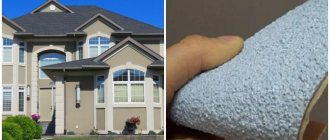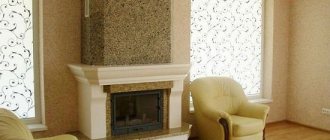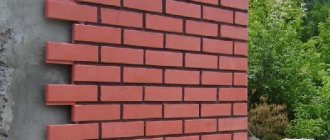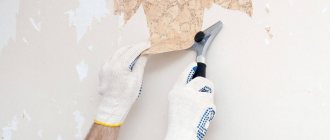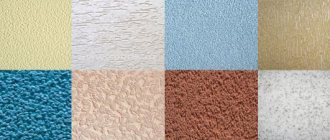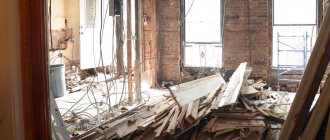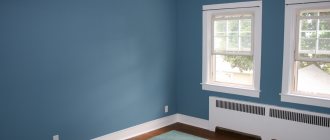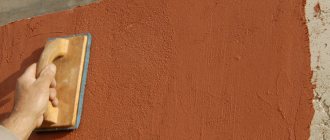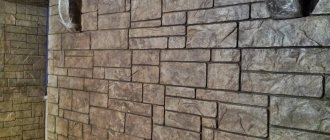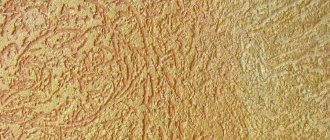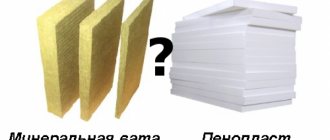According to some historical studies, decorative plaster was used more than 400 years ago. The application was varied: from the use of hand stencils to homemade patterns. Granite chip plaster was often used. The small fraction made it possible to make unusual divorces.
Choosing granite chip plaster
In a literal sense, initially the use of plaster was an art, since the complexity of the work and multiple technical nuances were not possible for everyone, and various secrets were strictly kept by the craftsmen.
Facade plaster with marble chips
Such mixtures are very diverse. And usually decorative effects are provided precisely by the filler - multi-colored and different-sized stone chips.
The effects are ensured precisely by the filler - multi-colored and different-sized stone chips.
Features of the material
In essence, this finishing material is a dust-crumb composition that is formed during the processing of marble. There are also other components in the mixture, for example, binders. They can be polymer resins, acrylic emulsions, coloring agents, lime additives and others (responsible for preserving color, hardening the plaster, and also antifungal).
This finishing material is a dust-crumb composition that is formed during the processing of marble.
Advantages and disadvantages
The positive qualities of the material marble facade plaster are as follows:
- Versatility - applicable to all surfaces;
- Environmental friendliness and safety of the components that make up the mixture;
- Long service life - paint with marble chips for the facade does not crack, there is no influence of humidity and changes in temperature, alkali-resistant;
- Fire safety – not subject to combustion;
- Manufacturability – easy to prepare, accessible and not difficult to master.
The main disadvantage of marble plaster for facades is its high price.
Typically, the finished coating requires final treatment with varnish or wax.
Paint with marble chips for the facade does not crack, there is no influence of humidity and changes in temperature, alkali-resistant.
Varieties of finishing with crumbs
This category includes all materials that contain granules of solid components. In fact, these are most of the known decorative materials with the exception of colored plasters, which create a smooth, monochromatic surface.
To size
The solid component is introduced into the mixture in different forms. The properties of the final solution depend on what size fraction was used in production.
The entire variety of compositions in relation to this factor is divided into 4 groups.
- Fine-textured - with a grain diameter from 0 to 0.5 mm - this is flour, dust and the smallest grain. The most famous representative of this category is Venetian plaster. And also silk, where stone chips are a smaller component than the silk and cotton fibers introduced into the composition.
This category also includes modeling compounds where the relief is created using special tools or processing methods.
- Fine-textured - with a granule size from 0.5 to 1.0 mm. The crumb in this case plays the role of the creator of a decorative effect, but is not one. These are traditional compositions for forming relief images. This kind of mixture is often called uniformly rough. They create a surface with the same fine grain – “fleece”, “lamb”.
- Medium textured - with a filler diameter from 1.5 to 3 mm. Most often, the crumb is the creator of a characteristic pattern or surface appearance. This includes many grooved-rough plasters with a small grain diameter - the same “bark beetle”, “Munich”. In this case, the relief is created by the movement of fairly large solid particles during the movement of a spatula or grater.
- Large-textured - with a granule size from 3 to 5 mm. The grains can form patterns - the same “bark beetle”, but larger and more pronounced. They can themselves represent a decorative effect, such as mosaic plaster. A large fraction is used here, with a bright color and, as a rule, more than one. Such “granulate” in appearance consists of pebbles of the same size. This category also includes grooved-rough relief plasters with a large fraction. Unlike mosaic ones, they are in most cases used for exterior decoration.
The filler undergoes special treatment before adding and is used in the form of spherical granules. The exception is special stone plaster, where the last stage is the formation of chips.
The video below will give important tips for working with plaster that includes stone chips:
By filler
The stone for plastering is selected based on its purpose. Thus, for fine- and medium-texture, it is important to form a relief pattern, and the color of the granule is preferably neutral. For small- and large-textured colors, color has a much more obvious meaning.
The following materials are most often used as fillers.
- Granite is an igneous rock composed of 60–65% feldspar, 20–25% quartz and 5–10% dark-colored mineral. The presence of the latter gives most granites a dark, completely uninteresting color. But if there is little or none of it, as in Alaskaite, the color of the rock can be much lighter and brighter. Granite is very widely used for cladding, facades and interior decoration, and crumbs and dust are used in the manufacture of decorative plasters.
- Marble is the most famous filler, since the material itself is used extremely widely. It is a metamorphic rock obtained by recrystallization of calcium carbonate. Marble can contain a wide variety of minerals and organics, which affect its properties and color. The color range is extremely varied. That’s why marble is used both for relief plasters and for thin-layer plasters, like Venetian plasters.
- Quartz is silicon dioxide. This substance can be found both in a free state and in a bound state; its total share in the mass of the earth’s crust is 60%. In plasters, it is used both in the form of quartz sand - this is an almost essential component of all cement and lime mixtures, and as granules of a certain size.
- Malachite is an extremely decorative mineral of all shades of green. Its basis is copper dihydrocarbonate. When crushed, it, of course, does not retain its unique pattern, but it does have excellent color and iridescent shades. Malachite is most often used in the manufacture of Venetian plaster.
- Serpentine or serpentinite is a rock of very complex composition, obtained by serpentinization of hyperbarites. It is distinguished by a rich range of green and gray-green shades. It is used to produce mosaic plaster.
- Jasper is a rock based on chalcedony and quartz. It is distinguished by exceptionally varied colors and is used in large-textured mosaic plasters.
- Lemesite is limestone with inclusions of dolomite, clay, quartz, and so on. There are also bright decorative shades, but quite rarely. Its usual color is grey. Belongs to the marble group and is used for cladding. Crumbs are used in the manufacture of mixtures where color is determined by coloring pigments.
- Gabbro is an igneous rock based on plagioclase and pyroxene. Due to its strength, it is often used for cladding. The main colors are black and dark green.
- Ophicalcite is a metamorphic rock based on calcite and chrysotile with inclusions of serpentine and other minerals. The main color is gray-green. As a rule, it is easier to find ophicalcite or gabbro chips to make textured plaster yourself.
In fact, almost any solid material that is not corroded by cement and lime can be used as a filler. Even a crumb of red clay brick can become the basis for decorative plaster.
Facade decorative plaster with granite and marble chips (photo)
By astringent
If the stone filler determines the decorative effect of the plaster, then the binder limits its use. The appearance of the composition may remain the same: for example, the “bark beetle” is produced on the basis of cement, acrylic, and silicone binders, but the properties of the plaster layer and the scope of application change noticeably.
- Mineral - the basis is cement, gypsum and lime. This immediately limits the choice of coloring pigments, because only alkali-resistant natural dyes can be added to such a mixture. The same applies to fillers: silk and cotton fibers, for example, are excluded, therefore the same silk or flock plaster is produced only on the basis of polymer resins. Cement and lime-cement mixtures are characterized by good resistance to moisture and good vapor permeability. This is a universal plaster that can be used for both exterior and interior use. Gypsum, on the contrary, is unstable to water. It can only be used for interior decoration and only living rooms with low levels of constant humidity.
- Acrylic mixtures - acrylic resin acts as a binder. This composition is more plastic, does not crack, is not afraid of water and “tolerates” any filler. The color range is very wide, because any pigment can be used here. All known types of thin-layer and relief plasters are produced on an acrylic basis. Acrylic compounds have low vapor permeability. For interior decoration, this, as a rule, is not considered a particular drawback, unless, of course, the ventilation in the house is properly equipped. But it’s not always suitable for exterior decoration. Thus, aerated concrete and foam concrete are more vapor permeable than acrylic plaster, which means they are not allowed to be used for finishing.
Another disadvantage is the low thermal threshold for operation. When heated in the sun, acrylic resin begins to soften. At the same time, dirt and dust eat into the coating tightly. Therefore, mixtures are not recommended for use in sunny areas.
- Silicate – based on liquid glass (sodium and potassium silicates). Its disadvantages include limited color range, and its advantages include vapor permeability. This mixture can be used to finish walls made of materials with high vapor permeability: aerated concrete, wood concrete, and so on.
- Silicone is distinguished by vapor permeability, plasticity, and resistance to water and mechanical damage. It belongs to universal mixtures - its use is essentially unlimited. The only drawback is the significant price.
Color range of marble mixture
Until recently, only a crumb of a natural shade was used in plaster, so there was no color variety. Also, the compositions of different releases were usually not the same in color, since the extracted marble layers were heterogeneous.
Now the problem has been solved: there are technologies by which the material acquires a natural color or shades close to natural.
Thanks to such technologies, there is enormous potential for bringing all kinds of design ideas and solutions to life. Today, in addition to the variety of natural shades, there are thousands of artificial ones. It is possible that marble chip plaster may consist of a unique assortment of colors.
Today, in addition to the variety of natural shades, there are thousands of artificial ones.
Compound
It is easy to guess that the filler is marble dust with crumbs formed during the processing of marble or other rocks.
The composition also includes other components for adhesion. For example, emulsions based on acrylic, polymer, lime, with coloring components, and other inclusions. Some of the components add a tint to the material, the rest helps the plaster harden faster and hold better.
The ingredients help protect the coating from the formation of mold, mildew - antiseptics, moisture protection products.
But the crumb will not stay on the base - a binder will be required. Resins on acrylic impart elasticity, strength, moisture resistance and other important qualities.
There are additives that prevent the formation of cracks when drying and repel dirt. Decorativeness and characteristics depend on the filler. The requirement is identical grain fractions. This will make the marble plaster smooth, monolithic, and the crumbs will be calibrated.
The sizes of the fractions correspond to the purpose of the material. Fine-grained mixtures are suitable for renovations inside buildings; large-grained mixtures are suitable for decorating facades.
Fractions in plaster
The base is usually also finished with coarse plaster. The larger the fraction, the stronger the foundation. The cost of the material, consumption, and layer thickness also depend on the diameter of the particles.
Where is it used?
Decorative plaster with marble chips is used at the start and finish of interior or exterior work of a room.
As a result of application, it looks discreet, however, stylish and impressive. It is suitable for finishing brick, concrete, plasterboard, wood, DS-boards and stone. And it stays on with water emulsion!
This material will help to create an aesthetic design on balconies, beautifully decorate colonnades, etc.
As a result of application, it looks discreet, however, stylish and impressive.
Nevertheless, such plaster is rarely used inside a residential building - it is considered “cold”. But the halls, staircases, corridor rooms with the use of material in the design - plaster with marble chips - seem harmonious. It also makes the facade very advantageous.
Halls, staircases, corridor rooms with the use of material in the design - plaster with marble chips - seem harmonious.
Finishing the facade with decorative plaster
Facade decorative plaster is the final finishing of the walls of a house, which creates a seamless coating and protects the building from the negative effects of atmospheric phenomena. The finishing technology is simple: the surface is cleaned of dirt, leveled with base plaster, and then covered with a decorative layer. This type of cladding can be used on any type of wall.
Advantages and disadvantages for outdoor work
A facade finished with a decorative coating helps reduce heat loss and extends the life of the building. Plaster mixtures are made with the addition of various components that give them strength and durability, and special modifiers increase resistance to frost and humidity.
The façade covering is characterized by:
- Good adhesive properties, suitable for application to various surfaces.
- Low maintenance requirements. You can clean the walls with a stream of water from a hose. Some types have the property of self-cleaning.
- Resistant to abrasion and mechanical stress.
- Safety and hydrophobicity (moisture resistance).
- Good vapor permeability, which creates a comfortable microclimate for the building.
- Excellent performance in different temperature conditions.
- Environmentally friendly, safe, there is no presence of toxic chemical elements in the composition.
- Ease of application.
Facade plaster protects buildings from adverse weather conditions. The coating breathes, which prevents the formation of efflorescence on the walls and the development of fungi.
The disadvantage of decorative coating is labor intensity, high cost of work and building materials used.
Wall decoration with marble plaster
Coating with such material is a responsible matter, it requires a careful approach, and as a result it can have different textures, color saturation, look discreet or, on the contrary, very expensive.
Coating with such material is a responsible matter and requires a careful approach.
Surface preparation
To do this, do the following:
- Clean the wall, remove the finishing, dismantling parts of the material that were not firmly fixed. The cracks are opened and primed. Then the holes are filled with gypsum or cement;
- Apply primer to the base. To ensure uniformity of the material, the wall is completely leveled with plaster, then dried and treated with a covering primer.
To ensure uniformity of the material, the wall is completely leveled with plaster, then dried and treated with a covering primer.
The solution is laid mechanically or manually
Manual coating
A small amount of the mixture is grabbed from the container with a small spatula, then evenly distributed over the pointed part of the wide one and applied to the surface with rubbing movements with minimal force. The optimal layer thickness is one and a half diameters of coarse-grained crumbs in the material.
The optimal layer thickness is one and a half diameters of coarse-grained crumbs in the material.
Mechanical method of finishing the surface with marble chips
For this method, a special pneumatic crumb thrower is used. They use it this way: the nozzle of the device is placed half a meter from the surface to be treated, and the mixture is “thrown” onto it in a top-down motion. Next, you need to smooth it out with a spatula or other suitable tool.
For this method, a special pneumatic crumb thrower is used.
Methods of applying the mixture
Step-by-step instructions on how to apply plaster:
- Purchase tools (a spatula with a wide base and a spatula with a narrow base) for applying the granite plaster itself;
- Remove the old plaster coating;
- Clean the dry surface from dust and dirt;
- Lay out the plaster;
- Wait until completely dry;
- Start laying out marble chips.
It is recommended to spread the plaster with a spatula.
Granite plaster is always applied to a dry and flat surface. If the wall initially turns out to be uneven, you need to cover up the defects with putty in advance. Next, you need to apply a primer to the surface.
If you want to decorate the walls with Venetian plaster, we recommend that you first level the surfaces with a thin layer of putty. Then, after leveling, sand it with sandpaper. Rough plaster is used when laying coarse-grained mixtures.
Ready-mixed marble plaster
For the convenience and speed of finishing the façade of a building, specialists actively use materials manufactured by the manufacturer. The following are in demand in the professional market:
- "Travertino";
- "Ferrara Design";
- "Novacolor";
- "Paladio Arabascato";
- "Gold Mineral" and many others.
How to apply them in practice? According to the attached instructions, add the required amount of water and mix the mixture.
Such compositions eliminate miscalculations in tone, even if there is still a need to purchase a certain amount of material - decorative marble chips plaster.
For the convenience and speed of finishing the façade of a building, specialists actively use materials manufactured by the manufacturer.
DIY granite plaster
This type of plaster is also made by hand. To do this, you will need a plaster mixture that contains granite chips. High-quality granite plaster can be achieved by adding granite and marble.
If you decide to make such plaster with your own hands, approach the process responsibly.
How to make your own mixture at home
Yes, this is also possible, and in certain situations it is even preferable.
Making mineral plaster yourself will significantly save your money.
You will need a container where the actual material itself—plaster made from marble chips or flour—plus a “binding” substance (light-colored cement or lime will do) and water are mixed in a ratio of 3:1:1. The resulting mixture is an excellent option for simulating marble facade plaster.
Making mineral plaster yourself will significantly save your money.
Depending on size
Solid components are introduced into mixtures in completely different forms. Depending on what fraction was used, the properties of the solution as a result of its preparation will be.
How to Learn Web Design Effectively?Flowers delivery in Chernivtsi – “Rose Bukovina”
- How is the production of concrete products carried out?
The compositions are as follows:
1. Fine-textured, in which the grains are 0-0.5 mm in diameter. This includes flour, dust, small grains. The most popular type of such material is Venetian and silk plaster. This includes compositions for modeling, and the relief is created with special tools.
2. Fine-textured, where the granules are 0.5-1.0 mm. Thanks to the crumbs, a decorative effect is created. It is traditional to make a relief image with this composition.
3. Medium-textured, in which the diameter is 1.5-3 mm, and thanks to the crumbs a pattern or a certain appearance is created on the surface of the walls.
4. Large-textured, with a diameter of 3-5 mm. The grains contribute to the formation of a variety of patterns, for example the same bark beetle, but larger and more pronounced. You can also create mosaic plaster based on marble chips.
- Where to sell cast iron for scrap in Moscow at a good price?
- Comprehensive development of web site design
- Advantages of timber houses
Additional façade painting using marble chips
After the applied material has dried, the surface is rubbed clean using a specially designed metal float. Next, to achieve maximum coating strength, a special varnish is applied in thin layers.
The structure of the mixture allows you to visually disguise small flaws.
In practice, it is easier to treat the façade of a building with the material described here than with conventional plaster. There is no need to ensure that everything “lays down” perfectly evenly. The structure of the mixture allows you to visually disguise small flaws.
Colors
The range has recently been limited to natural shades of marble. After application, the surface turned out to be heterogeneous, because marble from different layers was used in production.
According to the new technology, the composition contains different coloring components. They significantly expand the palette of plaster and help achieve color stability. The colors also withstand exposure to the sun's rays and retain their original color for 15 years outside and 25 years inside buildings.
Shades
Application instructions
Marble plaster requires following consistent instructions. Stages:
- Preparation.
- Application.
- Smoothing, processing.
- Final finishing.
Application
In the interior, marble-effect plaster is most often applied manually. During facade work, the volumes increase, so the walls are processed mechanically.
Tools
You need a few tools, the basic ones:
- a bucket or other container where the mixture is diluted;
- trowels for plaster composition;
- flat brush;
- drill;
- ruler;
- roller for soil and other materials.
Preparatory stage
Apply the crumbs to prepared, cleaned surfaces where there is no debris, dust, or visible defects. If cracks appear, they are sealed with concrete mortar to level them. Before applying plaster, a primer is needed.
After priming, wait for the composition to dry for about a day, at a temperature of at least plus 20 degrees.
Base finishing
This is the easiest part of the job. Decorating the basement is a training session before serious interior and façade repair work. Sequence subject to mandatory alignment and reinforcement:
- Preparation of the composition - coarse-grained plaster is more suitable for the base.
- Application. The mixture with stone chips is scooped up with a spatula, applied and stretched with a trowel.
- Drying.
Application
The base is an area located at a height of 1 m along the perimeter of the building.
- If the reinforcement mesh was not installed in the previous layers, it is secured with self-tapping screws, then secured with a solution containing a fine grain fraction.
- After drying, apply the plaster again using a solution containing coarse particles.
Application to the façade
For a single-color finish, you need to buy materials from one manufacturer, it is better if it is one batch. If the compositions from different brands are very similar in appearance, after application the shade and texture will change.
Before application, you need to properly prepare the walls. The base must be dry and thoroughly degreased so that the composition can reliably adhere to the wall. The base should not chalk. An uneven wall is puttied, the old coating is beaten off in advance, then plastered again. Old walls are primed with a strengthening primer. The base is primed to match the color of marble plaster at least 3 times.
After drying, proceed to coating with plaster:
- Using a narrow spatula, spread the composition evenly and spread it over the surface with little effort. The more leveling movements, the better. The layer thickness is no more than 1.5 grain fraction sizes.
- It is necessary to make 2-3 layers of cladding; after drying, each layer is leveled with a metal float for about 30 minutes.
- When the last layer has dried, it is coated with a protective varnish.
If the material is applied mechanically, the mass is sprayed at a distance of 50 cm from the wall, leveled and rubbed manually. This is more convenient to get an even layer.
To obtain a design or ornament, patterns and templates are used, which are made in full size. You can find ready-made wall frescoes that significantly transform the facade of the house.
Applying decor indoors
The process is almost no different from external repairs. But you need to use solutions with the smallest fractions. The inside of the building must have smooth walls, so the decorative layer is thin. After finishing is completed, it is necessary to additionally check the evenness of the walls. Drying will take approximately 24 hours, then waxing is carried out.
Varnish inside buildings is not recommended. The composition partially contains toxins, and they take a long time to disappear from the room.
Interior decoration
Technology of finishing walls with Bayramix
Marble plaster from the bayramix company is applied using a very old technology, which was used by Venetian masters. It has remained virtually unchanged and modern builders apply the finish in the same way.
The coarse-grained composition should be applied using a spatula over the entire surface so that no noticeable joints or transitions remain - using the “without lifting your hand” method. Adjacent layers should not be allowed to dry out quickly. You can even apply a coarse-grained finish to “rough” plaster.
Mixtures that have a medium or fine fraction must be applied exclusively to a smooth and pre-prepared surface. Application occurs in several stages, the sequence of which should be followed.
What tool is needed for the job?
Mineral plaster is quite easy to apply and requires the use of a minimal set of tools.
- A small bucket or basin - you need to dilute the plaster in it;
- Trowel and special grater;
- Flat brush;
- Construction mixer or drill;
- Roller and ruler.
Sometimes other tools may be required. Everything will depend on what kind of interior needs to be done.
Preparing the façade walls
Marble mixtures are the final coating. The surface under them must be perfectly flat and always dry. The wall is first cleaned of all kinds of dirt and dust, all cracks, holes and bulges are eliminated using cement-sand mortar. In those places where the old layer of plaster is most noticeable, it is better to remove it.
Cleaning and preparing walls
Areas of the wall that have mold or mildew must be cleaned and then treated with special products that contain a lot of chlorine.
The entire wall must be treated with an antiseptic so that other growths do not appear during the operation of the finish. If necessary, apply a layer of starting plaster or putty. After the surface has dried, it must be treated with a layer of primer.
How the mixture is prepared
Do not forget that the primer will dry for at least 12 hours. During this time, you can prepare the mixture for finishing the walls.
Preparing the mixture
In some situations, even purchased pebble plaster may be too thick. In this case, it should be diluted with water or a solvent, depending on the recommendations indicated on the packaging of the material.
Application technology
First, a small amount of the prepared solution is collected into the prepared containers using a trowel. After this, the mixture is transferred with a trowel to the trowel and then to the wall.
While applying the finish, the tool is held at an angle of approximately 60 degrees when viewed relative to the surface to which the material is being applied.
In most cases, wall surface treatment occurs in small squares. It is very important to ensure that the outer lines of the plaster do not have time to dry out during the working process.
Finishing
After the entire surface has been treated, you need to leave the finishing layer for half an hour. Only after this can you start rubbing it. A special grater made of stainless steel is pressed as tightly as possible against the wall. It is necessary to smooth marble plaster for internal walls or facades in a circle and be sure to apply the same force to all areas. Do not press the grater too hard or grate the same area for a long time.
This is what the end result looks like
The marble coating will dry completely in about a day. After 24 hours, you can coat the walls with varnish or special products with hydrophobic additives.
They will allow you to achieve a glossy shine. In addition, such products will increase the service life of the surface and protect it from various damages. After this, the walls are left for at least another 12 hours. This time is enough to completely dry and harden.
